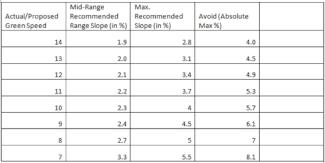Featured Golf News
Green Slopes for Maintenance - Part 2
As green speeds increased in modern times, there was perhaps an overreaction to flatten greens in some quarters. Some of it came from a tour pro-designer's ideas of playability, which is influenced by having one day each week to learn new greens before important tournaments, and having grooved their precision putting strokes. One pro-designer laughingly says, "I favor a wide variety of slopes on greens, from 1.5 to 1.6 percent."
Some better players argue that flat slopes are actually harder than gentle ones, and there is some truth to that as golfers can over-think things. Average golfers enjoy gently rolling greens, as long as they can keep the putt near the hole on long putts. I like the idea of variety on every green, so you can't get a gauge on a "typical putt." I try to vary the basic slopes as much as I can, within the constraints we are discussing.
Over the last decade, many clubs have flattened greens, sometimes at great expense. No doubt the new greens help keep members' egos high and handicaps and playing times low. And more club golfers seemingly believe that golf architecture should make the game easier for them. I was called to one club that wanted a flatter green on a hole simply because they had to "aim more than a foot outside the hole" from some locations. I did not agree, and do not consult at that club anymore.
So it has become a big challenge to get the green contours "just right" and in that sweet spot of breaking some, but "not too much." What is that magic slope?

Jerry Lemons, ASGCA, did some empirical research and produced a chart that I have adapted below, showing the maximum slopes for proposed cups, based on your green speed:
From experience, I design slopes about 10 percent less than even the mid-range "recommended slopes" shown in the first column, for a few reasons:
• Green speeds vary seasonally. In the fall, slow turf growth often produces the fastest greens of the year and putting must be possible then, too!
• Greens get faster for important tournaments. And, once seen, there is often the demand to see those speeds on an everyday basis.
• Construction Tolerances - Construction is rarely perfect. To assure maximum grade is attained, the superintendent can use all the green as planned so we allow a "fudge factor." Also, to attain the absolute minimum of 1.5-percent slope required to quickly drain greens - and reduce disease, ice buildup in the north, etc. - I rarely design with less than 1.65-1.75 percent slopes.
The precision needed these days requires an expert contractor and considerable field time by an expert architect to attain.
Jeffrey D. Brauer began his career as an apprentice in the Chicago area in 1977. His first project was Kemper Lakes, which shortly after hosted the 1989 PGA Championship. He formed GolfScapes in Arlington, Texas, in 1984. In the last 29 years he has designed and consulted on a wide spectrum of projects, ranging from partial renovations to international resorts. His recent work includes teaming with the design team of Pascuzzo and Pate on a remodel of the world-famous La Costa Resort & Spa in California, and renovations at Superior National Golf Course in Lutsen, Minn., and Mesquite Municipal Golf Course in Mesquite, Texas.
He has been a member of the American Society of Golf Course Architects since 1981, serving as President during its 50th Anniversary year in 1995-96. Jeff still studies the classic works - both old and new, and has played more than 75 of the best courses in the world.
Jeff gives many presentations and is a regular architecture columnist for many publications and websites, including Golf Course Industry and Cybergolf.com. He has also been a strong advocate for the "Tee it Forward" campaign and strives to make his courses fit the description of "fun to play every day."
Jeff's work has been spotlighted in most of the world's major golf magazines. Golf World ranked him as one of the top-20 golf course architects and Golf Inc. ranked him as the world's fourth-best value in golf architecture in 2010. Jeff's portfolio and reputation keep him at the forefront of desired designers for new courses, reconstruction and renovation projects. For more about Jeff, visit http://www.jeffreydbrauer.com/sites/courses/layout.asp?id=859&page=48451.
Story Options
 |
Print this Story |
